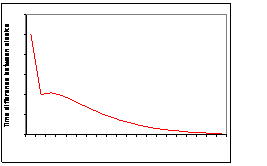
Page 18
WCNC 2005, New Orleans, LA, USA

WCNC 2005


A simple numerical
example
For
illustration purposes, consider the following manual
simulation
of CSMNS
0.5
1.5
3
S=1
S=2.6
1
2
3
t
S=2.72
4.5
…
T(t)
2.6
4.09
0.5
1.5
3
S=1
S=2.6
1
2
3
t
S=2.72
4.5
…
T(t)
2.6
4.09

0
0.2
0.4
0.6
0.8
1
1.2
1
2
3
4
5
6
7
8
9
10
11
12
13
14
15
16
17
18
19
20
Adjustment time (TBTTs in IEEE 802.11 terminology)
a)
b) Time difference between
the two clocks in first 20 updates
clocks 1 and 2
deviate +0.5 and -0.5 time units for every real-time unit
respectively. Assume zero initial conditions, and also that the
faster clock (1) always transmit in every opportunity. Figure a) shows
the virtual time for the first 3 updates using the following rule to
update the slope of the slower clock
where K is a
proportional gain similar to the gain of a proportional
controller in classic control theory to adjust the speed
of convergence and the stability properties of the algorithm. is the
timestamp embedded in the received beacon.



Clock
1
(faster)
1

Clock 2
2

